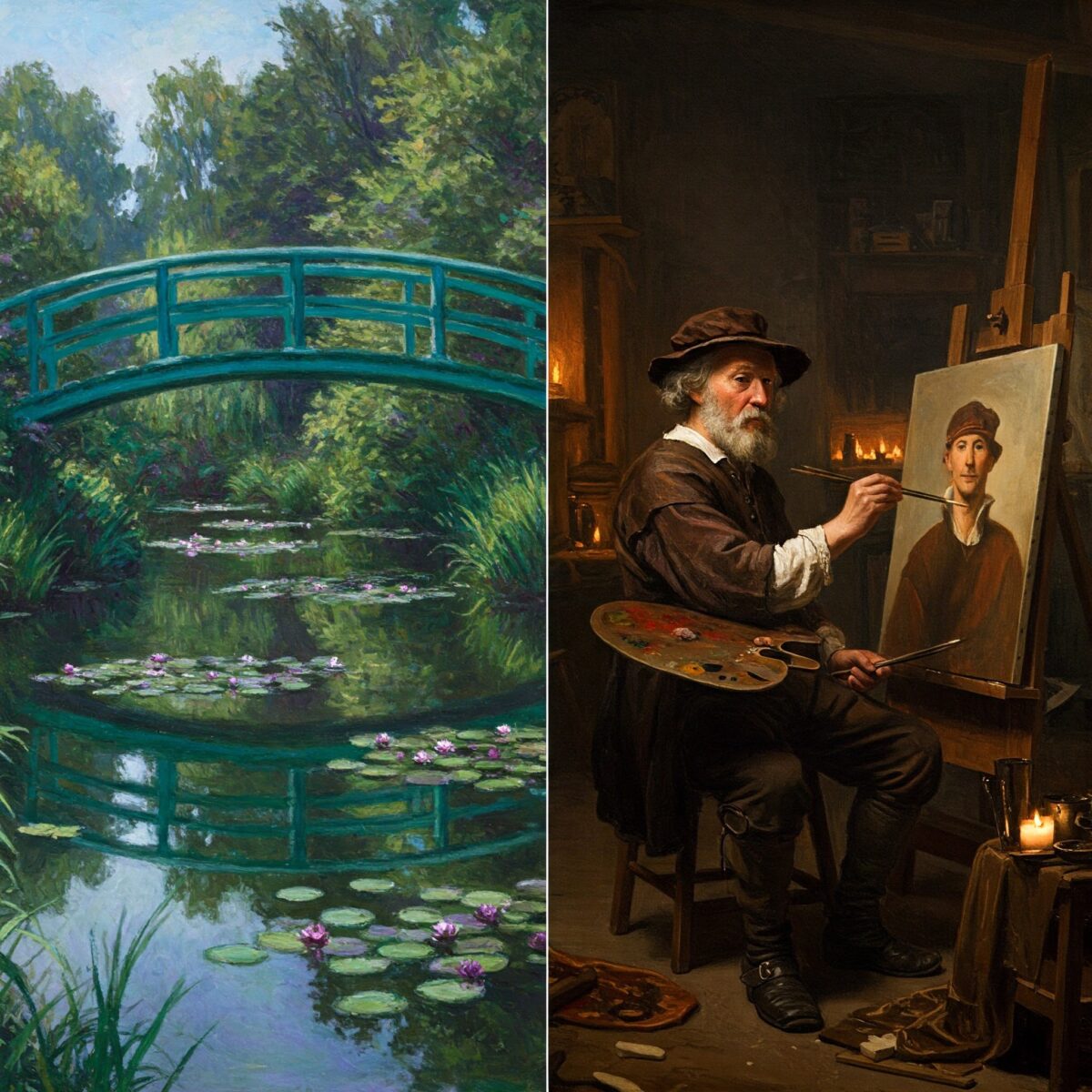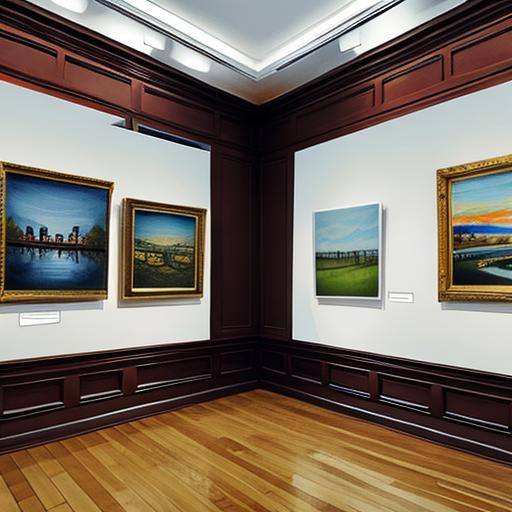Throughout art history, many famous artists poverty stories reveal a stark contrast between creative brilliance and financial reward. From Vincent van Gogh selling just one painting during his lifetime to Rembrandt dying nearly penniless, the “starving artist” stereotype has deep historical roots. Yet this narrative oversimplifies a complex reality – while some artistic geniuses lived and died in desperate conditions, others achieved both critical acclaim and substantial wealth during their lifetimes. This exploration of famous artists who experienced poverty against those who found financial success reveals how economic circumstances shaped artistic expression and how the art market’s evolution transformed the value of work sometimes only after an artist’s death.
Key Points:
- Many celebrated artists lived in extreme poverty despite creating what would become priceless masterpieces
- The commercial success of artists often came posthumously, with paintings worth millions today that sold for almost nothing during the artist’s lifetime
- Financial struggles influenced artistic choices, from paint quality to subject matter
- Art patronage systems historically determined which artists could succeed financially
- The “starving artist” stereotype persists but oversimplifies the complex relationship between artistic merit and commercial value
Famous Artists Poverty: The Struggle Behind the Masterpieces
Vincent van Gogh epitomizes the tragic irony of famous artists poverty. Despite creating over 900 paintings that would eventually be worth billions, he allegedly sold only one painting during his lifetime for about 400 francs (roughly $2,000 in today’s money). Van Gogh relied on his brother Theo’s financial support while living in conditions bordering on destitute. His letters reveal constant anxiety about money, yet he prioritized art supplies over food and comfort.
“I am a savage. And civilized people suspect this, for in my works there is nothing so surprisingand baffling as this ‘savage in spite of myself’ aspect.”
Paul Gauguin
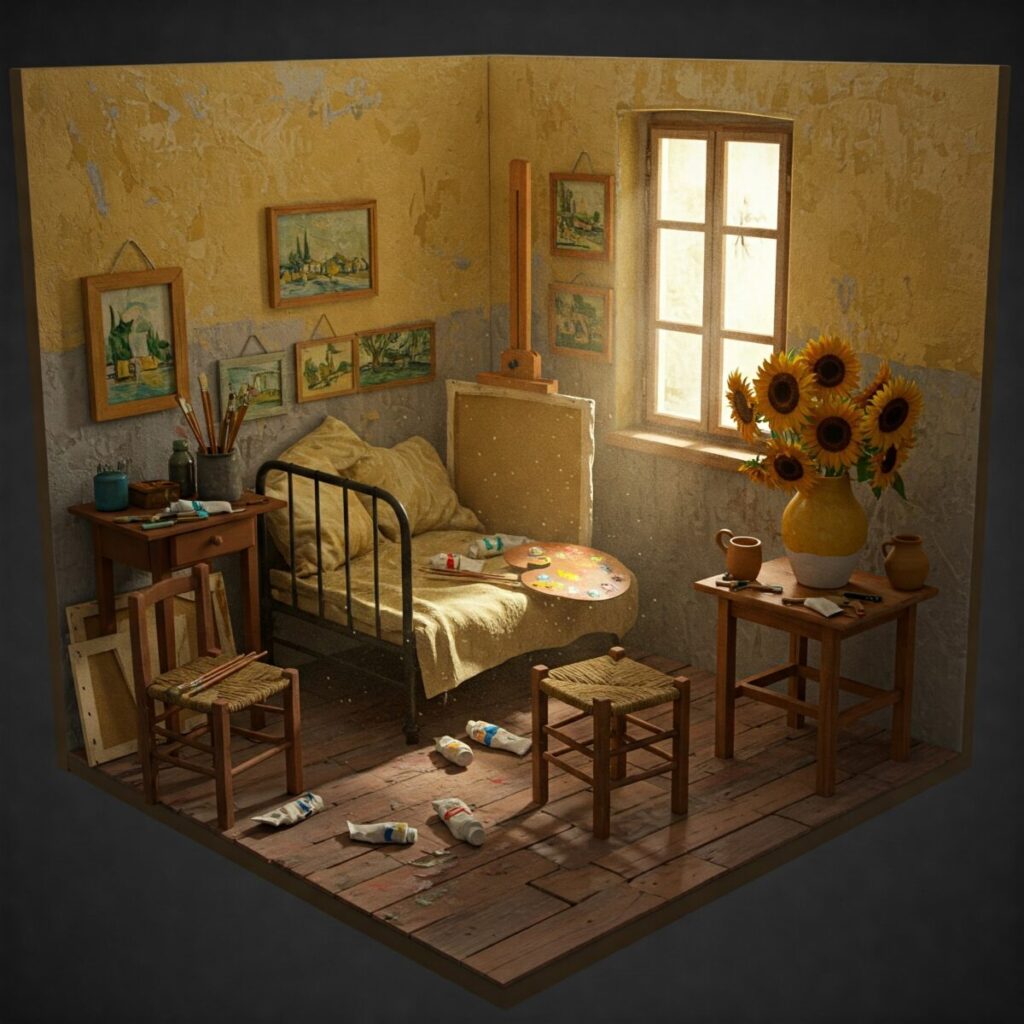
The story of Amedeo Modigliani presents another heartbreaking example. The Italian artist lived in extreme poverty in Paris, sometimes exchanging paintings for meals. He worked with whatever materials he could afford, often creating his signature elongated portraits on scavenged materials. In 2018, one of his nude paintings sold for $157.2 million – a fortune Modigliani could never have imagined while struggling to pay rent in his short life, which ended at just 35 years old.
Johannes Vermeer, now recognized as one of history’s greatest painters, died heavily in debt at age 43. After his death, his widow was forced to sell his paintings at drastically reduced prices to cover family debts. Today, with fewer than 35 authenticated Vermeer paintings in existence, each work is considered priceless.
The Economics of Artistic Struggle
Many factors contributed to famous artists poverty throughout history:
- Lack of institutional support – Before modern gallery systems, artists relied on wealthy patrons or institutional commissions
- Revolutionary styles – Artists whose work challenged prevailing aesthetics often struggled to find buyers
- Art market economics – The value of artwork was disconnected from technical skill or innovation
- Social status limitations – Many artists came from humble backgrounds without business connections
- Mental health and substance issues – Personal struggles sometimes prevented business success
- Absence of copyright protections – Artists often couldn’t profit from reproductions of their work
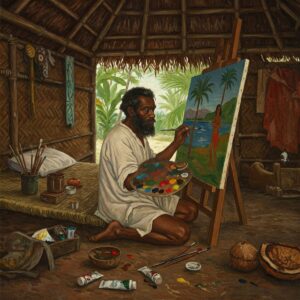
Paul Gauguin’s journey illustrates how artistic vision sometimes directly conflicts with financial security. Abandoning a successful career as a stockbroker and leaving his family behind, Gauguin pursued his artistic passions in Tahiti. Despite creating groundbreaking post-impressionist works, he lived in deteriorating conditions with minimal income from his art.
The Gatekeepers: Art Patronage and Market Forces
The financial fate of artists throughout history often depended on institutional support and patronage systems. The Paris Salon, the official art exhibition of the Académie des Beaux-Arts, effectively controlled artistic careers in 19th century France. Artists like Édouard Manet suffered financially when their works were rejected or ridiculed by the Salon.
Manet, from a wealthy family, could weather these rejections better than most. However, artists like Claude Monet experienced periods of extreme hardship when their revolutionary Impressionist approach alienated traditional buyers. Monet sometimes couldn’t afford food or rent, writing desperate letters seeking small loans while creating what would become million-dollar masterpieces.
Art patronage evolved significantly through history:
| Era | Primary Support System | Impact on Artists |
|---|---|---|
| Renaissance | Church and nobility patronage | Artists tied to patron demands |
| 17th-18th Century | Academy system and royal patronage | Success required institutional approval |
| 19th Century | Merchant class collectors and Salon system | Mixed support for traditional and new styles |
| Early 20th Century | Dealer-critic system emerges | Gallery owners became crucial gatekeepers |
| Contemporary | Diverse ecosystem: galleries, museums, collectors, grants | Multiple paths to financial success |

From Rags to Posthumous Riches
The cruel irony of famous artists poverty stories is how dramatically their fortunes changed after death. Works that couldn’t fetch enough to pay for a meal during the artist’s lifetime now sell for tens or hundreds of millions at auction.
Rembrandt van Rijn achieved significant success early in his career but died nearly bankrupt after financial mismanagement and changing tastes reduced demand for his work. Today, Rembrandt’s paintings regularly sell for tens of millions – in 2009, his portrait “Portrait of a Man” sold for $33 million.
El Greco sold his works for modest sums during his lifetime and died with significant debts. His distinctive style fell out of favor until the early 20th century when modern artists recognized his genius. Now, his paintings are among the most valuable in the world.
Jean-François Millet lived modestly while creating influential works depicting peasant life. Just fourteen years after his death, his painting “The Angelus” sold for 800,000 francs – about 6,000 times what Millet received when he first sold it.

Artists Who Succeeded Financially in Their Lifetime
Not all great artists suffered poverty. Some managed to achieve both artistic innovation and financial security:
Pablo Picasso became exceptionally wealthy during his lifetime through prolific output and business savvy. Unlike many struggling artists, Picasso understood his market value and negotiated accordingly. His estate was worth approximately $250 million when he died in 1973 (over $1.5 billion in today’s dollars).
Peter Paul Rubens operated a large studio with numerous assistants, effectively functioning as a successful business. His diplomatic connections helped secure lucrative commissions from European royalty.
Salvador Dalí combined artistic talent with remarkable self-promotion skills. By embracing commercial opportunities and cultivating his eccentric persona, Dalí amassed significant wealth through art sales and endorsements.
Andy Warhol redefined the relationship between art and commerce, creating a personal brand that generated wealth through multiple income streams beyond traditional painting.
Check out our article on pop art reflecting the influence of earlier artists to see how Warhol’s approach revolutionized the art market.
The Contrasting Journeys
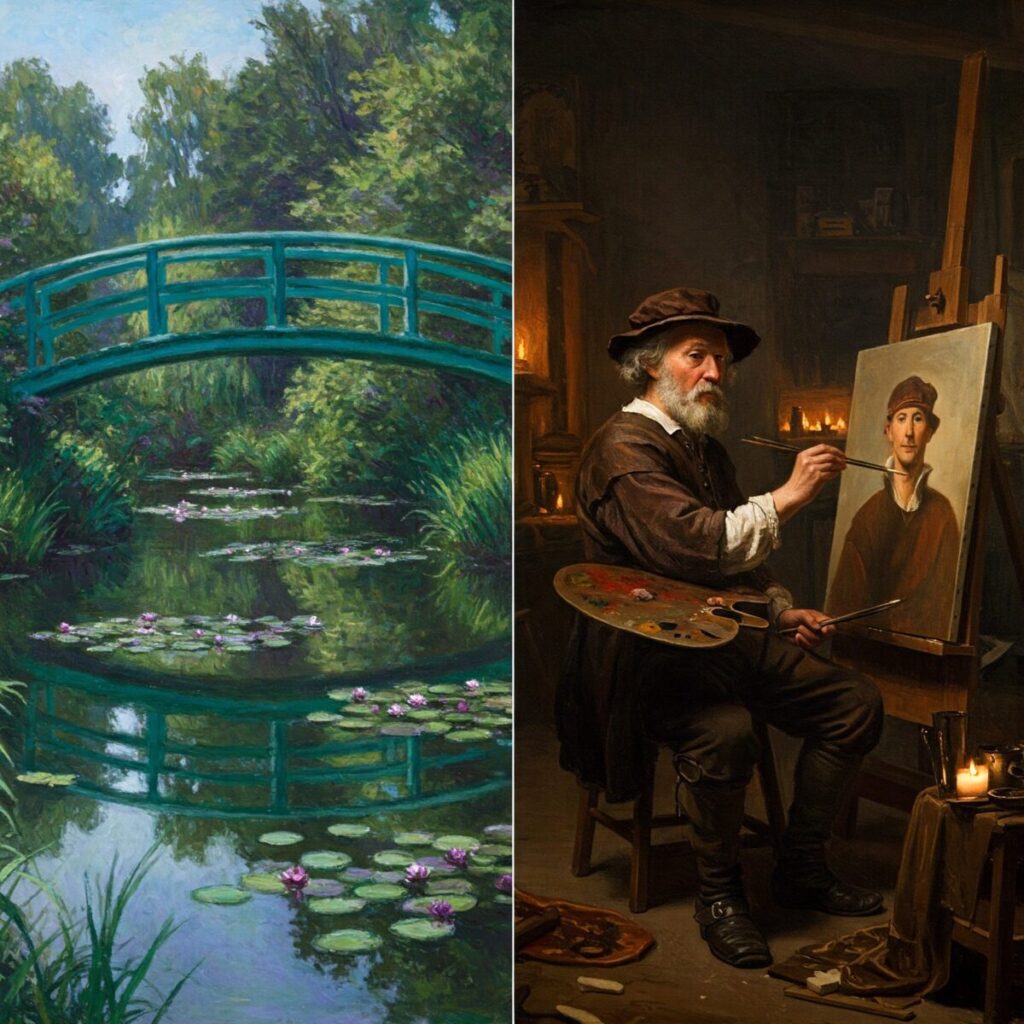
Claude Monet’s story demonstrates how an artist’s financial fortunes could change within their lifetime. For decades, Monet struggled financially, sometimes unable to buy food or art supplies. However, unlike many who died in poverty, Monet lived long enough (until age 86) to witness his work gain recognition and substantial value. In his later years, he achieved financial security and could develop his famous garden at Giverny, which inspired his iconic water lily series.
For deeper insights into Monet’s evolving style, read our article on 10 most famous Claude Monet paintings you need to see.
Henri Rousseau offers another compelling example of famous artists poverty. Working as a toll collector, Rousseau painted in a distinctive “naive” style that drew ridicule from critics during his lifetime. He died in poverty but is now recognized as an influential self-taught artist whose works hang in major museums worldwide.
Lessons from Art History’s Economic Divide
The stories of famous artists poverty contain valuable lessons about art, commerce, and recognition:
- Market timing matters – Artists working ahead of public taste often failed commercially during their lifetimes
- Business skills impact success – Artists with entrepreneurial abilities typically fared better financially
- Support systems are crucial – Family wealth or patron support often determined who could continue creating
- Art valuation is complex – The highest-priced artworks today weren’t necessarily the most valued in their time
- Recognition requires advocates – Many artists gained fame posthumously through champions of their work
For a broader perspective on what determines art value today, explore our article about what makes paintings valuable – unveiling the secrets behind art’s worth.
The art market has transformed dramatically since the days when Van Gogh couldn’t sell his paintings. Today’s artists have more paths to financial sustainability through online platforms, social media marketing, and diverse revenue streams. Yet the fundamental tension between artistic innovation and commercial appeal remains.
The value of art now extends beyond traditional metrics into the realm of investment, with major auction houses and collectors treating artwork as financial assets. Learn more about these trends in our coverage of art market auction trends shaping 2025.
The Enduring Myth and Reality
The “starving artist” stereotype persists in popular culture, romanticizing the notion that true artistic genius requires suffering and sacrifice. While famous artists poverty stories show this was often tragically true historically, the complete picture is more nuanced.
Today, we recognize that economic stability can provide artists with freedom to create their best work. Organizations like the Artists Financial Support Group and government grants in many countries aim to prevent the next Van Gogh or Modigliani from creating masterpieces while unable to afford healthcare or housing.
Understanding famous artists poverty stories helps us appreciate not just the aesthetic value of great artwork, but the human cost behind its creation. It reminds us to support living artists adequately rather than perpetuating a system that rewards artistic innovation only after the creator can no longer benefit.
Comparison Table: Famous Artists’ Income/Sales When Alive vs. After Death
| Artist | Income/Sales When Alive | Income/Sales After Death (Recent/Notable Sales) |
|---|---|---|
| Leonardo da Vinci | Annual salary from nobles: 1,000–2,000 gold ducats (~$2–3 million/year in today’s money) | Paintings now considered priceless; individual works valued at hundreds of millions at auction. |
| Michelangelo | Amassed a fortune worth over $67 million (today’s money) through commissions | Works are national treasures; rarely sold, but estimated value per piece is in the hundreds of millions. |
| Claude Monet | Sold well in his lifetime, owned a large estate | “Meules” sold for $110.7 million in 2019. |
| Vincent van Gogh | Sold only one painting in his lifetime, died in poverty | “Portrait of Dr. Gachet” sold for $82.5 million (1990); works now regularly fetch $50–100+ million. |
| Pablo Picasso | Died with $4.5 million in cash, $1.3 million in gold, and a vast art collection | “Les Femmes d’Alger” sold for $179.4 million (2015). |
| Salvador Dalí | Died with a fortune of hundreds of millions of dollars | Works continue to sell for millions; estate value remains high. |
| David Hockney | “Portrait of an Artist” sold for $90.3 million while alive | Works continue to appreciate; no posthumous sales as of 2025. |
| Jeff Koons | “Balloon Dog (Orange)” sold for $58.4 million while alive | Still living; no posthumous sales. |
| Jean-Michel Basquiat | Sold works for thousands in the 1980s; lived modestly | “Untitled” sold for $110.5 million (2017). |
| Rembrandt | Lived in luxury for much of his life, but died in financial trouble | Paintings now valued in the tens of millions; rarely sold. |
| Peter Paul Rubens | Born wealthy, received expensive commissions, owned a mansion and estate | Paintings valued in the tens of millions at auction. |
Key Insights
- Old Masters like Leonardo, Michelangelo, and Rubens were often well-compensated in their lifetimes through patronage and commissions, sometimes amassing fortunes equivalent to tens of millions today
- Modern Artists such as Picasso and Dalí were also wealthy while alive, but the value of their works has soared even higher posthumously, with individual paintings selling for over $100 million.
- Van Gogh is a classic example of an artist who was unrecognized and impoverished in life, but whose works now command some of the highest prices in art history.
- Contemporary Artists like Hockney and Koons have achieved record-breaking sales while still alive, reflecting a shift in the art market where living artists can now see immense financial success.
- Posthumous Sales often far exceed what artists earned in their lifetimes, especially for those who were not wealthy while alive (e.g., Van Gogh, Basquiat).
This table highlights the dramatic difference between the financial realities artists faced during their lifetimes and the astronomical values their works can achieve after death, driven by rarity, legacy, and market demand.
FAQ: Famous Artists Poverty
Did Van Gogh sell only one painting in his lifetime?
While the common belief is that Van Gogh sold only one painting during his lifetime (The Red Vineyard), research suggests he may have sold a few more. However, the number was certainly minimal compared to the hundreds he created, and the prices were extremely low.
Which famous artists were successful during their lives?
Pablo Picasso, Peter Paul Rubens, Salvador Dalí, Andy Warhol, and J.M.W. Turner achieved significant financial success during their lifetimes. Their business acumen, market awareness, and self-promotion skills contributed to their commercial success alongside their artistic talents.
Why do artists become famous after death?
Posthumous fame often occurs because: 1) Artists were ahead of their time aesthetically, 2) Their work gains scarcity value after their death, 3) Champions promote their legacy, 4) Their life story becomes romanticized, and 5) Academic reassessment brings renewed attention to their innovations.
How did poverty affect artistic expression?
Poverty influenced artists’ work through material limitations (cheaper pigments, reused canvases), subject matter choices (depicting their surroundings), emotional content (themes of struggle), technical decisions (working quickly to save materials), and sometimes creating more commercial work to generate income.
Who was the richest artist in history?
When adjusted for inflation, Pablo Picasso likely ranks among the wealthiest artists in history with an estate valued at approximately $1.5 billion in today’s dollars. Among living artists, Damien Hirst, Jeff Koons, and Jasper Johns have achieved fortunes exceeding $300 million through their art.
The stark contrast between famous artists poverty during life and the astronomical values their works command today remains one of art history’s most poignant paradoxes. As we admire masterpieces in museums and marvel at auction records, we should remember the human stories behind the canvas – tales of struggle, persistence, and the often-delayed recognition of genius.

